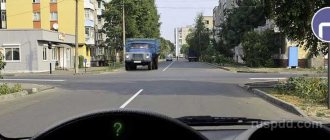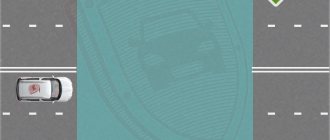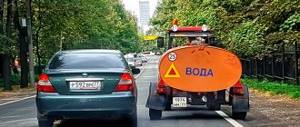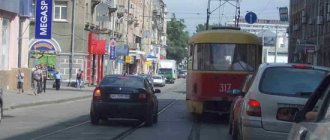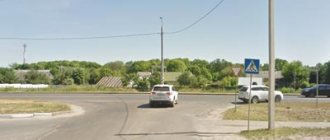It is an absolutely obvious fact that knowledge and compliance with road safety rules is a vital necessity for both pedestrians and drivers. The set of provisions specifies the basic requirements for all road users, including recommendations for driving a vehicle in various situations.
Dear readers! Our articles talk about typical ways to resolve legal issues, but each case is unique. If you want to find out how to solve your particular problem, please use the online consultant form on the right or call. It's fast and free!
Today we will discuss in more detail the algorithm for the movement of vehicles when changing lanes, analyze the most common mistakes made by drivers, and learn how to avoid emergency situations when performing this maneuver.
Rules for changing lanes on the road
The principles of moving a vehicle are reflected in Chapter 8 of the Regulations on Traffic Regulations of the Russian Federation:
- Clause 8.1. The road traffic regulations require that before starting to move or change lanes, the driver must give a light signal with the direction indicators about the direction of the car. During the maneuver, there should be no interference or danger for other road users.
- Clause 8.4. regulates that when moving from one road lane to another, the driver is obliged to give way to vehicles moving in the same direction, without changing its trajectory. If a situation arises when vehicles moving in the same direction simultaneously change lanes, the vehicle on the right has priority.
There are stages that can roughly be called an action plan for the driver when changing lanes:
- Objectively assess the situation on the road.
- Turn on the direction indicator lights.
- To control what is happening, you need to look in the rearview mirror.
- Change lanes and turn off the indicator lights.
It is important to understand that moving a vehicle from one lane to another requires objectivity, calculation and maximum attention from the driver to carry out the maneuver.
Subclause 9.6
In the traffic rules, driving in lanes when there is heavy congestion involves traveling along tram tracks. The rules say that passing tram tracks are permitted, but only if the trackless vehicle lanes are full. When moving in this manner, the car should not interfere with the tram. But traveling onto oncoming tram tracks is strictly prohibited.
When making a turn, vehicles must change lanes onto tram tracks in the same direction and make the turn from them. If the road is regulated by road signs indicating the direction of travel, then turning from the tracks is prohibited. In such cases, a turn can only be made by crossing the tram tracks at the intersection.
Simultaneous lane change
Often, for various reasons - some due to inexperience, some due to excessive self-confidence in personal driving experience, do not properly perceive the fact that the main problem when changing lanes is to adequately assess what is happening on the road.
It should be noted that the Traffic Rules regulate cases in which changing lanes is legally justified, these are:
- left turn;
- right turn;
- reversal This maneuver must be carried out while approaching the intersection in order to make a U-turn from the permitted lane.
In addition, in paragraph 8.4 of the traffic rules, we have already discussed this provision earlier, the principles of simultaneous lane changes are indicated.
Now we will look at several options for simultaneously changing lanes, which are quite common in everyday life:
- You enter the lane on the left. A vehicle from the left lane is also trying to change lanes. In this case, the car is obliged to give way to you; the “right hand” rule applies here. However, you should not lose your vigilance and rush headlong, you need to make sure that they really let you through and only then carry out the maneuver.
- You move to the lane that is on your right. The driver of the car in the right lane also changes lanes. In this case, you must give way.
Width - carriageway - road
The approach clearance for highways, roads laid in tunnels, under bridges, overpasses, viaducts, galleries, overpasses and overhead pipelines must be in width not less than the width of the roadway, increased by 1 m, and in height - not less than 5 m. taking into account the dimensions of vehicles and transported goods.
The location of the supports should be taken as single-row on the left side of the road along the path of vehicles (Fig. 7.6) at a distance of 2 - 3 75 m from the edge of the roadway, depending on the category of crossing and the width of the roadway.
Cargo storage areas and access roads are indicated on the construction site plan. The width of the carriageway for one-way traffic is assumed to be 3–5 m, the minimum radius of curvature is 10 m; the coating is made from slag, crushed stone or defective reinforced concrete slabs.
Due to the possibility of movement of repair equipment on caterpillar tracks on the territory of the compressor station, on-site roads should be designed with a rigid surface (monolithic cement concrete or prefabricated reinforced concrete slabs), and the choice of the type of coating should be economically justified. The width of the carriageway of on-site roads should be no more than 3 5 - 4 5 m and a multiple of the dimensions of the road slabs. In addition, these roads must be secured with curb stones.
The boom is made in the form of a spatial truss, hingedly connected to the forklift carriage. The grab grab has a rotating mechanism that allows you to unfold timber up to 6-5 m long by 180 and, by transporting logs deployed along the loader, reduce the width of the roadway and improve the use of the lower warehouse area.
In the outdoor switchgear, with three-phase short circuit currents of 20 kA and more, flexible busbars are checked for the possibility of twisting or approaching dangerous in relation to breakdown as a result of the dynamic action of short-circuit currents. In the outdoor switchgear, a passage of at least 4 m in width and height is provided along the switches for the transportation of mobile installation and repair mechanisms and devices, as well as mobile laboratories. It is allowed to have a width of the carriageway of various on-site roads of 3–5 m or more, and when determining the dimensions of the passages, the dimensions of the mechanisms and devices used must be taken into account.
Railways usually intersect with horse-drawn roads at the same level. At the places of such intersections, crossings are arranged. The width of the crossing at the level of the rails must be at least 4-5 m and not less than the width of the carriageway.
The lamps have different lighting designs. They consist of reflective, refractive and scattering elements. Depending on the combination of these elements, luminaires can provide different luminous intensity curves in the vertical and horizontal planes. Thus, in accordance with the vertical plane, wide, semi-wide, cosine and sine are created, and in the horizontal plane, in accordance with the classification, symmetrical, lateral, axial and four-sided luminous intensity curves are created. For outdoor lighting lamps, in addition to light distribution, the technical documentation indicates the coefficients of amplification of the lamp's luminous intensity by optical elements and the coefficients of illumination utilization for various ratios of the width of the roadway to the height of the lamp suspension.
Changing lanes in traffic
Unfortunately, some drivers assume that when changing lanes, only dense traffic flow is dangerous. This is a misconception. The fact is that driving on roads with low traffic volume dulls concentration, which runs the risk of not being able to see a vehicle in the blind spot in time, or not noticing a moving motorcycle.
The dead zone is a rather dangerous “phenomenon”, which represents a situation when the vehicle has already disappeared from the view of the side rear mirror, but has not yet appeared in the window.
To neutralize the negative influence of the dead zone, it is important to correctly adjust the view of the rear view mirror.
You should also pay special attention to the fact that you should not change several lanes at once. This can provoke a serious traffic accident, since the driver is unlikely to be able to adequately assess what is happening. The restructuring must take place in stages.
Changing lanes in the ring
Roundabouts are quite common in populated areas. The purpose of their creation was to make it easier to cross the road and avoid delays in traffic. But these rules only work at average traffic intensity, when the number of vehicles on the road increases significantly, traffic jams begin and the number of accidents sharply increases.
The most important thing to remember is that the rules for changing lanes in a traffic circle are absolutely identical to the principles for changing lanes on a straight road. The only caveat is leaving the ring. This maneuver must be carried out from the far right lane, but in no case from the left.
Let's sum it up
Today in Russia the laws are quite complex. Many court hearings for traffic violations end unfairly, forcing drivers to abandon the use of motor vehicles while their driver's license is revoked. In recent years, the situation with traffic police lawlessness on the roads has improved significantly; new rules for communication with inspection officers, as well as stricter requirements for the duties of the police, have become an important point in reducing the tension in relations between drivers and the traffic police. But certain controversial situations remain.
If our country monitored the quality of roads, provided signs and road markings for all traffic areas, much fewer controversial situations would arise. If such a controversial situation arises in your driving practice, do not rush to despair, contact a lawyer and preserve your rights. It is likely that unlawful police demands will be overturned in court if you are properly prepared to defend your rights. Have you ever won cases against the traffic police in court?
According to the current SNiP 2.05.02-85 “Roads for the movement of motor vehicles,” the width of the lanes is provided for by the current category of the road and can be 3.75 m, 3.5 m, and 3 meters.
The minimum width of the part for auto traffic in 4-lane operation should be 15 meters, i.e. The width of the lanes on this road is 3.75 meters. In SNiP 2.07.01-89 “Urban development” a lane of 2.75 m is allowed for driveways, and for 4-lane traffic the minimum road width is
should be equal to 14 meters.
What is enshrined in GOST R 52289-2004: “When marking roads, the width of the traffic lane is taken taking into account the individual categories of roads, which meets the requirements of current construction rules and regulations. On roads whose transverse profiles do not meet the requirements of current construction standards and regulations, the width of this marked travel lane must be at least three meters. It is allowed to reduce the width of the road
, or one of its lanes intended for the movement of passenger cars, to 2.75 m, subject to the main condition of introducing some restrictions on the traffic regime.”
Table of lane widths depending on the road category according to SNiP 2.07.01-89
| Design speed, km/h | Lane width, m | Number of lanes |
| Main roads: | ||
| high-speed traffic | ||
| controlled movement | ||
| Main streets: | ||
| of citywide significance: | ||
| continuous movement | ||
| controlled movement | ||
| regional significance: | ||
| transport and pedestrian | ||
| pedestrian and transport | ||
| Local streets and roads: | ||
| residential streets | ||
| streets and roads of scientific-production, industrial and municipal-warehouse areas | ||
| park roads | ||
| Directions: | ||
| basic | ||
| minor | ||
| Pedestrian streets: | ||
| basic | By calculation | |
| minor | ||
| Bicycle paths: | ||
| isolated | ||
| isolated |
Thus, with the width of the road
less than 12 meters (4*3 m) it is absolutely pointless to talk about using 4 lanes. Indeed, the width of a 4-lane road should be 14 meters in the city and about 15 meters outside the city.
Is it a lot or a little? The width of the VAZ-2110 with fixed mirrors is about 1875 mm, i.e. four cars will take 7.5 meters. Let a gap of 0.5 meters be fixed between them. In total, about 9 meters are required for tight travel. This is the postulate that various careless inspectors use: will four cars move apart? They'll disperse! Therefore, 4 lanes, which means Article 12.15, paragraph 3 or 4 of the Administrative Code. No need to be shy, you need to measure the width of the road.
You need to measure only the actual width. For example, in winter the road is narrowed due to the presence of snow dumps. Measure the width from the edge of the blade to the second edge of the blade, rather than looking for the curb underneath.
There is no need to take into account the broadening of the terrain
Driving through an intersection on a yellow traffic light Why is a driver's license revoked in court? Drifting into oncoming traffic at an intersection with a median Violation of traffic rules? The one who knows the rules is right. Traffic police order 185 is useful for car drivers to know.
How to avoid accidents when changing lanes?
There are certain rules that must be followed to avoid serious mistakes, because they, in turn, can lead to serious vehicle accidents:
- If there is no vehicle in the rear-view mirrors, you need to look out the side windows of the car. How to carry out this manipulation so that control over the control of the machine is in no case lost, and moreover, if an emergency situation arises, there is time to react and make the right decision.
- When driving in heavy traffic, you need to be able to use “pockets”. This is the distance between closely moving vehicles, with which you can maneuver.
- When changing lanes into an adjacent lane, you need to adequately assess the speed of the vehicle towards which you plan to move.
- If you are maneuvering into a lane where the average traffic speed is higher than yours, there is a need to move with empathy.
To summarize, it should be noted the need to comply not only with basic norms and rules of behavior on the road, but also with the principles of changing a vehicle lane in certain situations. We must not forget that, according to statistics, the number of accidents when changing lanes is much higher than during other types of maneuvering.
Remember that you need to be not only a law-abiding driver, but at the same time remain a Person who respects other road users. If everyone tries to behave accordingly, then the number of traffic jams and accidents on the roads will certainly decrease.
Didn't find the answer to your question? Find out how to solve exactly your problem - call right now: +7 (Moscow) +7 (812) 309-53-42 (St. Petersburg) It's fast and free!
Free online consultation with a car lawyer
Didn't find the answer to your question? Find out how to solve exactly your problem - call right now: +7 (Moscow) +7 (812) 309-53-42 (St. Petersburg) It's fast and free!
Determination of lane width in Russia
There are many road options, from country roads to highways. And it would be wrong to introduce a single defining indicator of lane width. Therefore, the rules contain divisions into types of roads; each type has its own recommendations for lane width. However, these recommendations are not mandatory for road services, so in our country a highway with a lane width of around 3 meters is quite possible. Today, the recommended requirements for traffic lane rules are as follows:
- roads without asphalt, concrete or other type of covering - not determined, width can be any;
- streets within the settlement, which have the status of secondary passages, have a width of 2.75 meters;
- streets of district significance in cities and towns, defined by pedestrian and transport highways, have a lane width from 2.75 to 4 meters;
- Intercity roads of categories 1 and 2 provide the driver with a lane width of 3.75 meters;
- Category 3 roads between cities are defined by a lane width of 3.5 meters;
- Category 4 roads have a transport lane of at least 3 meters;
- Any roads for mixed traffic, including trucks and buses, must be no narrower than 3 meters.
Such requirements must be observed, first of all, during the construction of roads, as well as when applying road markings. In reality, services are guided by other values. For example, there is a road that needs to be marked. Three lanes will be allocated on it, which means the road is divided into three equal parts and markings are carried out in accordance with this mathematical calculation. In fact, this approach often turns out to be ineffective, since on many roads there may well be a first lane due to the constant parking of a large number of vehicles on it. These are the subtleties in Russian legislation regarding the width of a traffic lane.

